Mankind’s fascination with owls dates back millennia, but what is it about these secretive birds that has captured our imagination and where can you find them in the UK asks Matthew Dennison
MANKIND’s fascination with owls is age-old. Wall paintings in a cave in south-west France depict a pair of snowy owls and their chicks that last preyed on small mammals and regurgitated pellets some 15,000 years ago. The Stone Age artist who sketched those pale contours died millennia before the author of the book of Leviticus cautioned against avian predators that the Bible categorises as “an abomination”: carrion-eaters including “the owl, and the nighthawk, and the cuckoo… and the little owl, and the cormorant, and the great owl”. In the Cave of the Trois-Frères, snowy owls, deftly chipped into the rockface, take their place in a fearsome inventory of hunter-gatherers and grazing beasts that includes bison, lions and a wounded bear vomiting blood.
OWLS AND WHERE TO FIND THEM IN THE UK
Owls are among the nation’s favourite birds. In 2015, a countrywide poll to choose Britain’s national bird placed the barn owl – one of four native species, alongside tawny, long- and short-eared owls – in second place, after the robin. Following long years of decline in the middle of the past century, numbers of barn owls and tawny owls are currently buoyant. Recent estimates suggest around 12,000 breeding pairs of barn owls and 50,000 pairs of tawny owls across the UK.
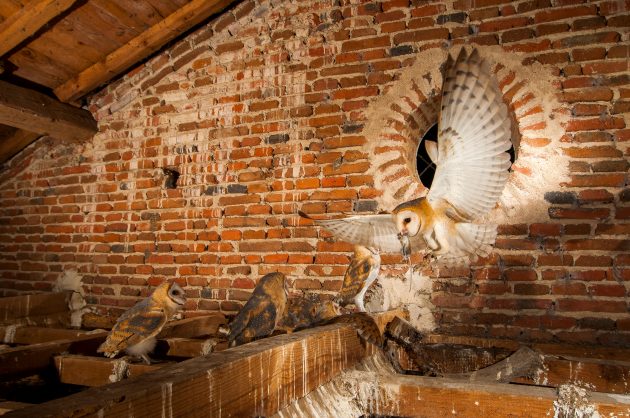
Yet the majority of town-dwelling Britons will never glimpse an owl in its native habitat, despite some tawny owls making their homes in gardens and urban parks. How, then, to account for the birds’ extraordinary popularity?
The owl is woven into the weft of the British imagination. At heart it may be, as one natural history writer described it, “a cat with wings… a creature superbly adapted for hunting small rodents, watching silently till the time for the fast approach and the moment of truth”, but for centuries, folklore, ballads, popular storytelling, nonsense rhymes and superstitions have celebrated this remarkable bird as more than a flat-faced, fluffy-feathered, nocturnal predator.
Owls appear in medieval poetry, the work of Shakespeare and children’s authors from AA Milne to JK Rowling. The distinctive clear hoot of the tawny owl – a signal of territorial ownership described by poet Alfred Noyes as the after-dark “long haloo” – is recognised by adults and children alike, as familiar to Londoners as to their country cousins. “I’m not quite myself till the sun’s down,” the Owl tells Eustace in CS Lewis’ Narnia story The Silver Chair. For many people, owls – with their haunting call, moonlit flight and night-time habits that, in the case of the long-eared owl, the RSPB has labelled “secretive” – are synonymous with the inky evenings of autumn and winter.
“Owls,” JK Rowling has explained, “have been associated with magic for a long time, and feature in many old illustrations of witches and wizards, second only to cats as Most Magical Creature.” Earlier generations attributed to owls an association with the supernatural. This included clairvoyance – as the Owl tells its opponent in the late-12th-century poem The Owl and the Nightingale, “When I sit on my branch, I see and realise very clearly that harm is about to come to someone.” – and more prosaically, but no less usefully, the ability to predict changes in the weather.
A barn owl’s screech once spelled an imminent storm or the arrival of a cold snap; the sound of an owl above the raging of a storm foreshadowed further dramatic changes. Even into the 19th century, farmers nailed an owl to a barn door to ward off lightning, while fears of a barn owl’s screech as a herald of doom persisted into the past century, recalling Puck’s reminder, in A Midsummer Night’s Dream, that “the screech-owl, screeching loud/Puts the wretch that lies in woe/In remembrance of a shroud.”
More positively, owls were believed to possess curative qualities. Mothers treated children suffering from whooping cough with owl broth, while an owl egg, eaten raw, was a trusted remedy for alcoholism. Less surprising, given the birds’ ability to see in the dark, was the belief that an owl’s egg, charred to ashes, had the power to improve eyesight. On account of their softness and the bird’s nocturnal associations, owl feathers were believed to help sleep.
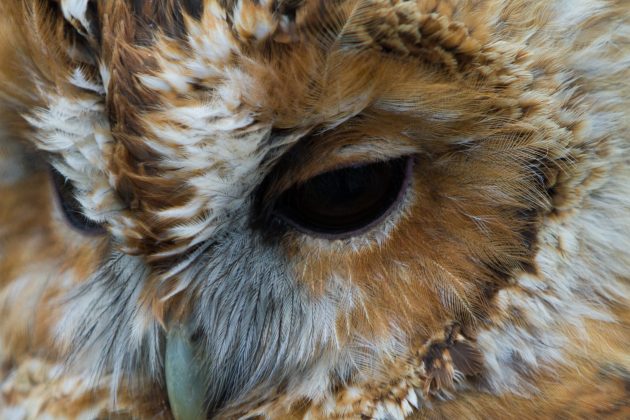
WISDOM AND KNOWLEDGE
Owls’ special status in these islands was partly shaped by classical precedent. For Greeks and Romans, owls were no ordinary birds. In ancient Greece, owls’ link with the goddess Athena shaped their association with wisdom and knowledge. Commentators disagree on the origin of the link between goddess and bird. It survives, for example, on coinage and vase painting. This includes the painted decoration on a terracotta oil flask of the fifth century BC in the collection of the Metropolitan Museum of Art in New York, on which a spear-bearing goddess is accompanied by a particularly small little owl. Even today, the little owl’s Latin name is Athene noctua, and owl imagery can be found, for example, on Athene’s helmet in surviving Greek painted and carved representations of the goddess.
BIRDS OF OMEN
Perhaps on account of the owl’s enormous, night-seeing eyes, we retain Greek-influenced ideas of the bird’s wisdom. ‘A wise old owl,’ runs the proverb, ‘lived in an oak/The more he saw, the less he spoke/The less he spoke, the more he heard/Why can’t we all be like that wise old bird?’ Other ancient associations were more sinister. In his version of a witch’s incantation, the Roman poet Horace included “the feathers and eggs of nocturnal screech-owls/All smeared with the blood of vile toads”. This may have influenced Shakespeare, whose witches’ cauldron in Macbeth includes among its unlovely ingredients an owl’s wing. Sir Walter Scott placed owls among an inventory of “birds of omen, dark and foul”.

In an old English folktale, a dishonest daughter is punished by being transformed into an owl. A baker’s wife makes a special loaf for Christ. So large is the loaf that her daughter claims it is too big for the baker’s oven and tears off much of the dough, shrinking its size. The dough that remains, however, swells to huge proportions. Astonished, the daughter yells out in protest, and her cries become those of an owl as she herself is transformed into a bird.
The steady erosion of superstition and traditional rural beliefs has reduced earlier ways of thinking to quaint souvenirs of a pre-scientific society, and today it is children, with their facility for belief in magic, among whom earlier associations thrive. Owls continue to feature in children’s fiction, especially historical and fantasy fiction. Harry Potter’s snowy owl, Hedwig, an 11th birthday present from Hagrid, and the owl post at Hogwarts placed the birds back on the map for a generation of schoolchildren: even the trade in antique stuffed owls has benefited as a result. And Rowling’s is not the only owl to play an important part in her fictional hero’s life.
Inspired by ancient Celtic myths and the Mabinogion, Alan Garner’s The Owl Service is dominated by owls’ elusive symbolism, while Merlin’s owl Archimedes helps shape the Wart’s education in The Sword and the Stone. Perhaps the key to owls’ enduring attraction for children is their near-anthropomorphic appearance. “The owl hides the tools of his trade beneath a soft billowing plumage,” wrote one author; he “faces the world with an upright, cuddly, human posture, with a cheek-like facial disc, great big round eyes and little ear tufts”.
WHERE TO SEE OWLS IN THE UK
Five species of owl live and breed in the UK: the tawny owl, barn owl, long-eared and short-eared owls and the little owl, the last a non-native species that was introduced to Britain by Lord Lilford in 1842. All British owls are predominantly nocturnal, which inevitably lessens opportunities for seeing the birds.
BARN OWLS
Barn owls occur throughout England, Wales and Northern Ireland but are not recorded in central, north-east and the far north of Scotland and the Outer Hebrides, Orkney and Shetland. In the past, they nested inside tree cavities and farm buildings – hence their name – though the majority today breed in artificial nest boxes, following the redevelopment of so many stone-built farm buildings. Barn owls feed on ground-level small mammals and, especially in autumn and winter, can be seen hunting at dusk and even dawn, their white underbellies and pale heart-shaped faces distinctive in the half-light. Glimpsed in daylight, it is clear that barn owls are pale coppery brown speckled with grey.
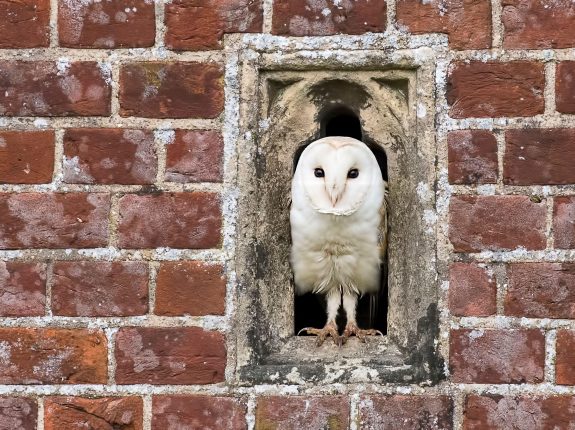
TAWNY OWLS
The tawny owl’s preferred habitat is broadleaf woodland scattered across England, Scotland and Wales. There are no tawny owls in Ireland, nor in high mountain habitats above the treeline, though the birds have adapted to live in villages and even some urban areas. The tawny is geographically unadventurous. Following expulsion from the parental nest, pairs often find the nearest possible tree for their own nesting site, where they will remain for the rest of their lives. Hunting is almost exclusively confined to night-time, limiting opportunities to see a tawny owl.
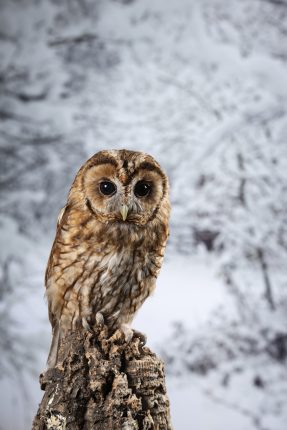
LONG-EARED OWLS
In Britain, there are fewer long-eared owls than barn or tawny owls. They live in coniferous and mixed woodland, with a preference for the dense cover offered by conifers, hedgerows and shrubby thickets. They breed across the country, though there are few long-eared owls in southwest England or Wales, and, given habits that the Woodland Trust characterises as “extremely elusive”, they are most likely to be seen when migrating, either travelling to and from roosting sites in winter or migrating to warmer coastal areas.
SHORT-EARED OWLS
The medium-sized short-eared owl is most often seen in winter, skimming over wetlands, saltmarshes or moorland. Its daytime, winter hunting at dawn and dusk gives it a degree of visibility. Its preferred ground-level breeding sites are in Scotland, in areas of mixed rough grassland and heather, and northern England, though winter distribution is greater, including the Fens and the island of Anglesey.
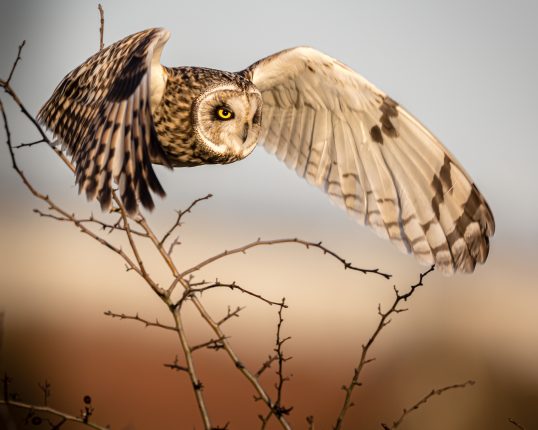
LITTLE OWLS
In hedgerows, farmland, orchards, copses and parkland across England and Wales, the doughty little owl (pictured above) can often be seen on tree stumps, fence posts and telegraph poles, and so are more likely than other British owl species to make themselves visible in the open. They are most common in southern, central and south-east England and the Welsh borders, scarce in Scotland and central and coastal Wales, and, like short-eared owls, can be spied hunting at first and last light.




